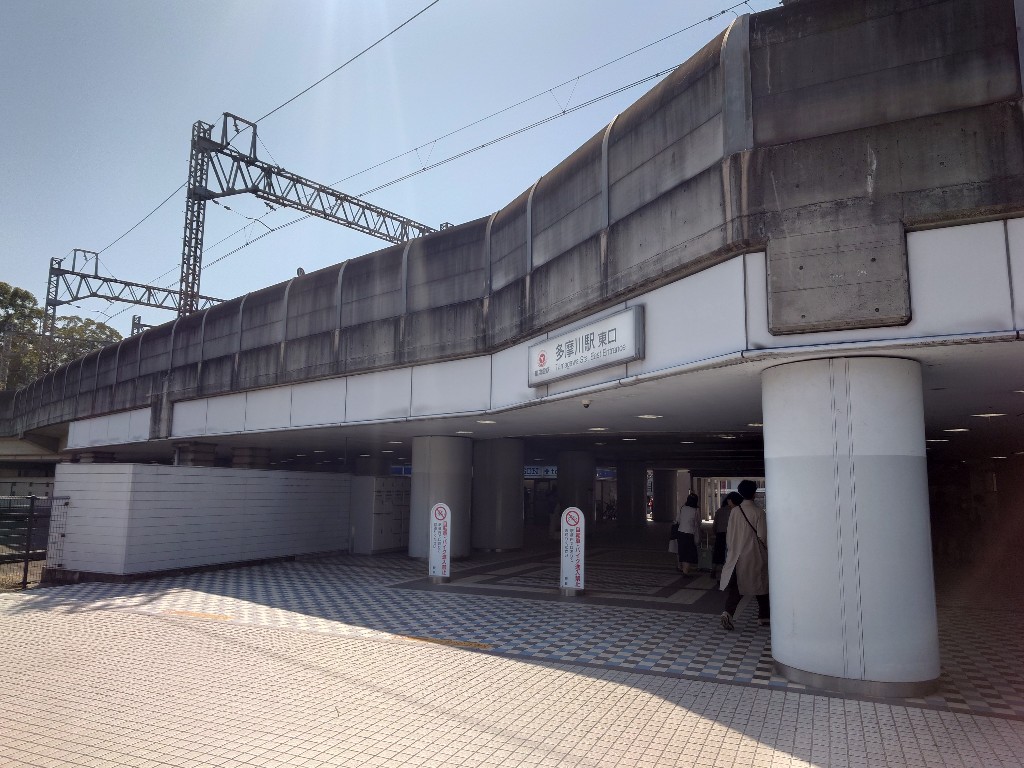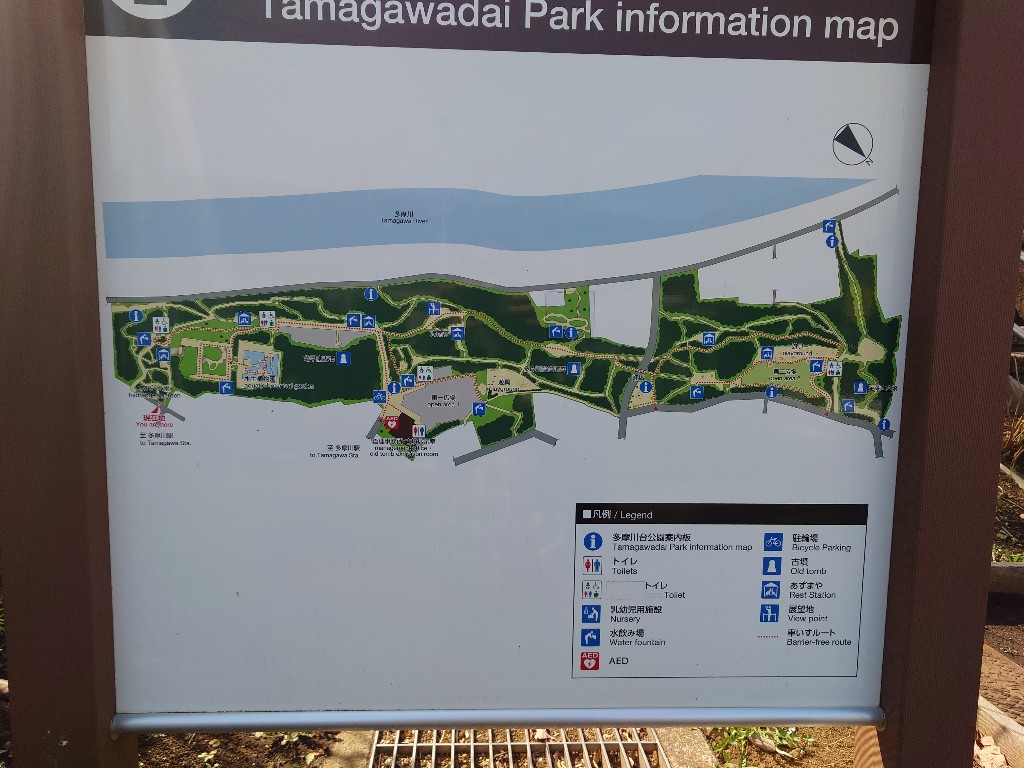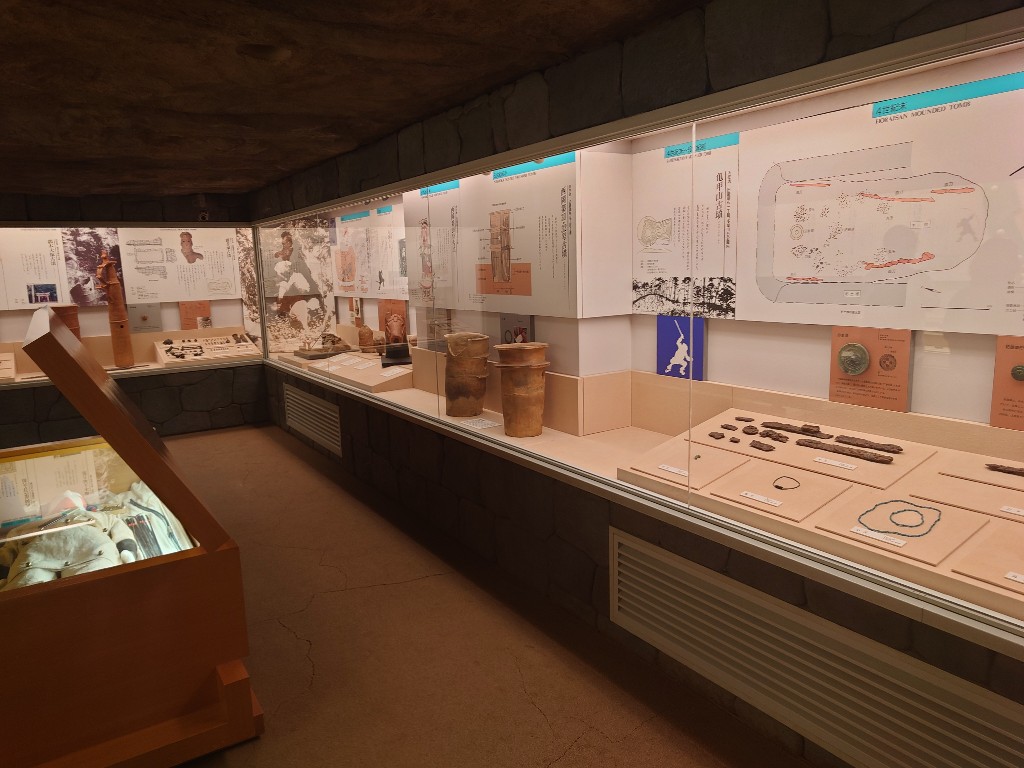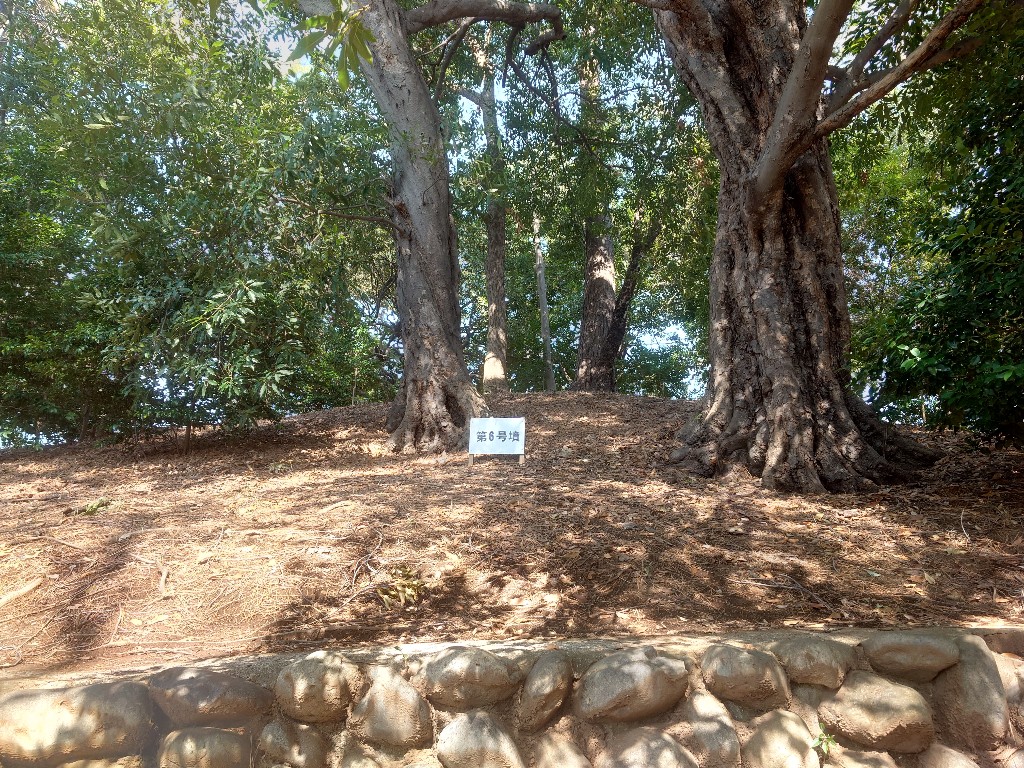カテゴリ: 都内近郊散策

On an unusually warm weekend, I spontaneously got off at Tamagawa Station on the Tokyu Toyoko Line. Although it’s a stop for express trains, it was my first time getting off there.

住宅街を抜けると、多摩川の堤沿いに細長い大きな公園がある。ここが今回の目的地、多摩川台公園だ。
この公園内には、亀甲山古墳と宝来山古墳という2つの大型前方後円墳と、8基の円墳からなる多摩川台古墳群がある。これらの古墳は、近隣の野毛古墳群とともに、合計40基ともいわれる荏原台古墳群(えばらだいこふんぐん)を形成している。
Passing through a residential area, I reached a long, narrow park along the Tamagawa River. This was my destination for the day: Tamagawadai Park.
Within the park are two large keyhole-shaped kofun, Kamenokoyama Kofun and Horaisan Kofun, along with eight round burial mounds, forming the Tamagawadai Kofun Cluster. Together with the nearby Noge Kofun Cluster, these sites make up the Ebaradai Kofun Cluster, which is said to comprise a total of around 40 burial mounds.

階段を上ってすぐのところに、亀甲山古墳がある。大仙陵古墳などをはじめとする関西の巨大古墳とは比べるべくもないが、それでも墳丘長107.25メートルというのはなかなかの規模だ。実際、南武蔵地域・多摩川流域では最大規模とのこと。
Just past the stairs stands Kamenokoyama Kofun. While it can’t compare to the massive kofun of the Kansai region, such as Daisenryo Kofun, its mound length of 107.25 meters is still impressive. In fact, it’s the largest kofun in the South Musashi area along the Tamagawa River.

後円部の一部は浄水場建設にあたり削平されてしまったが、他の墳丘は良好に遺存している。大田区教育委員会による測量調査が実施されているが、発掘調査は実施されていない。

古墳域の周囲は柵で囲まれ、立ち入りは制限されている。
The kofun area is fenced off, and access is restricted.

下から見上げても、このように草木が生い茂った丘にしか見えず、正直面白いものではない。
築造時期は古墳時代中期の4世紀末葉-5世紀初頭頃と推定され、荏原台古墳群では宝萊山古墳に次ぐ古さだ。
Even when viewed from below, it just looks like a grassy, overgrown hill, and to be honest, it’s not particularly exciting. The mound is estimated to have been constructed in the late 4th to early 5th century, during the middle Kofun period, making it the second-oldest in the Ebaradai Kofun Cluster after Horaisan Kofun.

すぐ近くにある公園管理事務所の「古墳展示室」では、荏原台古墳群の古墳分布を紹介し、公園内の古墳からの出土品を展示している。大きくはないが、丁寧な展示と説明には好感が持てる。
At the Kofun Exhibition Room in the nearby park management office, the distribution of kofun in the Ebaradai Cluster is introduced, and artifacts excavated from the park’s mounds are on display. It’s not a large space, but the careful presentation and explanations are quite impressive.

墓室内を再現した展示は、知らずに近づくとギョッとするリアルさ。
多摩川下流域にはこれら以外にもかつて多くの古墳が存在していたが、その多くは宅地化に伴い破壊されてしまったとのこと。考えてみれば、このエリアも田園調布に隣接しているわけで、こうして10基もの古墳が公園となって保存されているのはすごいことだと思う。
The exhibit recreating an actual burial chamber is startlingly realistic if you approach it without warning. Many other kofun once existed in the lower Tamagawa area, but most were destroyed as the land was developed for housing. Come to think of it, this area is adjacent to Den-en Chofu, so the fact that ten kofun have been preserved as a park is truly remarkable.

公園は道路を隔てて、多摩川沿いに広がっている。ちょっとしたハイキング気分を味わえるが、夜はきっと少し寂しいのではないかと思う。

公園西端の宝来山古墳に向かう途中、8基の円墳が次々と現れる。いずれも、ちょっとした起伏に過ぎず、表記がなければ、それと気づかないレベルだ。これらの円墳はいずれも年代的には後年に作られたもので、概ね6~7世紀ごろと推定されているそうだ。
On the way to Horaisan Kofun at the western end of the park, eight round mounds appear one after another. Each is just a slight rise in the ground, and without markers, you might not even realize they are kofun. These round mounds were built later than the larger mounds, and are estimated to date from around the 6th to 7th centuries.
お気に入りの記事を「いいね!」で応援しよう
[都内近郊散策] カテゴリの最新記事
-
ぶらり東京散歩38~原宿太田美術館からハ… 2025年11月13日
-
「渋谷を駄目にした 鉄道会社どもーー再開… 2025年11月12日
-
モーリス・ユトリロ展@SOMPO美術館~その2 2025年11月11日
【毎日開催】
15記事にいいね!で1ポイント
10秒滞在
いいね!
--
/
--
PR
X
Comments
shuz1127
@ Re[1]:モーリス・ユトリロ展@SOMPO美術館~その1 Maurice Utrillo Exhibition at the SOMPO Museum — Part 1(11/10)
Henryさん おお、西山美術館に行かれたの…
Henry@ Re:モーリス・ユトリロ展@SOMPO美術館~その1 Maurice Utrillo Exhibition at the SOMPO Museum — Part 1(11/10)
西山美術館、メルカリで無料招待券をお安…
shuz1127
@ Re[1]:ほどよく均整の取れたベリーA~マスカットベリーA2023(白百合醸造) Well-Balanced Berry A – Muscat Bailey A 2023 (Shirayuri Winery)(10/10)
noir-funさんへ 熊本ワインファーム、例…
noir-fun
@ Re:ほどよく均整の取れたベリーA~マスカットベリーA2023(白百合醸造) Well-Balanced Berry A – Muscat Bailey A 2023 (Shirayuri Winery)(10/10)
機会があれば是非、熊本ワインファームの…
shuz@ Re[1]:悪くはないのだけど…エラスリス MAX・カベルネソーヴィニヨン2020 “Not bad, but not quite…” — Errazuriz MAX Cabernet Sauvignon 2020(09/24)
noir-funさん ご無沙汰していますが、お…
Category
カテゴリ未分類
(10)お知らせ・リンク集
(28)ワイン新着情報
(517)ワインコラム
(343)ワインコラム2(話飲徒然草拾遺集)
(75)ワインコラム3(RWGコラム拾遺集)
(28)都内近郊散策
(281)こんな店に行った
(327)B級グルメ・カフェ
(248)健康
(219)エッセイ
(76)ひとりごと・備忘録
(541)カミサン推薦ネタ
(28)語学・資格・学び直し
(95)山歩き・ハイキング
(123)アクアリウム・ガーデニング
(339)育児・教育
(88)PCネット時計カメラ
(129)音楽・オーディオ
(70)リフォーム引越し
(50)こんなワイン買った
(129)ボルドー
(99)ブルゴーニュ・ジュブレシャンベルタン
(90)ブルゴーニュ・モレサンドニ
(40)ブルゴーニュ・シャンボールミュジニー
(45)ブルゴーニュ・ヴォーヌロマネ・ヴジョ
(56)ブルゴーニュ・NSG
(58)ブルゴーニュ・その他コートドニュイ
(63)ブルゴーニュ・コルトン・ポマール・ヴォルネイ
(30)ブルゴーニュ・ボーヌ周辺
(56)ブル・ピュリニー・シャサーニュ・ムルソー
(21)ブルゴーニュ・その他コートドボーヌ
(27)ブルゴーニュ・裾モノイッキ飲み!
(221)ブルゴーニュ・その他地域
(37)ボジョレー再発見プロジェクト
(32)シャンパーニュ
(195)ロワール・アルザス・ローヌ
(54)その他フランス
(16)イタリア
(80)スペイン・ポルトガル
(37)ニュージーランド・オーストラリア
(49)USA
(40)安泡道場(シャンパーニュ以外)
(37)その他地域・甘口など
(43)日本ワイン
(64)ワイン会・有料試飲
(173) 【ラーメン】秋葉原…
 New!
ささだあきらさん
New!
ささだあきらさん
10年前のルロワのプ… yonemuさん
yonemuさん
モロー・ノーデ シ… mache2007さん
mache2007さん
ジャッキー・トルシ… hirozeauxさん
hirozeauxさん
貝殻亭でランチ zzz.santaさん
zzz.santaさん
EF210-328 EF510-3… musigny0209さん
実南 月一会 ミユウミリウさん
ミユウミリウさん
ワイン&ジョギング … Char@diaryさん
道草日記 旅・釣… 道草.さん
鴨がワインしょって… うまいーちさん
 New!
ささだあきらさん
New!
ささだあきらさん10年前のルロワのプ…
 yonemuさん
yonemuさんモロー・ノーデ シ…
 mache2007さん
mache2007さんジャッキー・トルシ…
 hirozeauxさん
hirozeauxさん貝殻亭でランチ
 zzz.santaさん
zzz.santaさんEF210-328 EF510-3… musigny0209さん
実南 月一会
 ミユウミリウさん
ミユウミリウさんワイン&ジョギング … Char@diaryさん
道草日記 旅・釣… 道草.さん
鴨がワインしょって… うまいーちさん
Keyword Search
▼キーワード検索
Calendar
© Rakuten Group, Inc.









